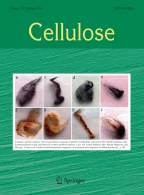Abstract
Distinct bacterial species belonging to the family of enterobacteriaceae produce cellulose as an exopolysaccharide. Cellulose produced by Salmonella enterica serovar Typhimurium was isolated by various methods. Subsequently, transmission electron microscopy (TEM) studies of the isolated material revealed novel structural details of enterobacterial cellulose.
Similar content being viewed by others
Explore related subjects
Discover the latest articles, news and stories from top researchers in related subjects.References
Ausmees N., Jonsson H., Hoglund S., Ljunggren H.and Lindberg M.1999.Structural and putative regulatory genes involved in cellulose synthesis in Rhizobium leguminosarum bv.trifolii.Microbiology 145(Pt 5):1253–1262.
Benziman M., Haigler C.H., Brown Jr. R.M., White A.R.and Cooper K.M.1980.Cellulose biogenesis:polymerization and crystallization are coupled processes in Acetobacter xylinum. Proc.Natl.Acad.Sci.USA 77:6678–6682.
Brown Jr. R.M., Willison J.H.and Richardson C.L.1976. Cellulose biosynthesis in Acetobacter xylinum:visualization of the site of synthesis and direct measurement of the in vivo process.Proc.Natl.Acad.Sci.USA 73:4565–4569.
Gerstel U.and Ro ¨mling U.2001.Oxygen tension and nutrient starvation are major signals that regulate agfD promoter activity and expression of the multicellular mor-photype in Salmonella typhimurium. Environ.Microbiol.3: 638–648.
Haigler C.H., Brown Jr. R.M.and Benziman M.1980.Calcofluor white ST alters the in vivo assembly of cellulose mi-cro brils.Science 210:903–906.
Lin F.C., Brown Jr. R.M., Cooper J.B.and Delmer D.P.1985. Synthesis of brils in vitro by a solubilized cellulose synthase from Acetobacter xylinum. Science 230:822–825.
Nobles D.R., Romanovicz D.K.and Brown Jr. R.M.2001. Cellulose in cyanobacteria.Origin of vascular plant cellulose synthase?Plant Physiol.127:529–542.
Ro ¨mling U.2002.Molecular biology of cellulose production in bacteria.Res.Microbiol.153:205–212.
Ro ¨mling U., Bokranz W., Gerstel U., Lunsdorf H., Nimtz M., Rabsch W., Tscha ¨pe H.and Zogaj X.2003.Dissection of the genetic pathway leading to multicellular behaviour in Salmonella Typhimurium and other Enterobacteriaceae.In: Wilson M.and Devine D.(eds),Medical Implications of Bio lms.Cambridge University Press, Cambridge,UK, pp.231–261.
Ro ¨mling U., Rohde M., Olsen A., Normark S.and Reinko ¨ster J.2000.AgfD,the checkpoint of multicellular and aggrega-tive behaviour in Salmonella typhimurium regulates at least two independent pathways.Mol.Microbiol.36:10–23.
Ro ¨mling U., Sierralta W.D., Eriksson K.and Normark S.1998. Multicellular and aggregative behaviour of Salmonella typhimurium strains is controlled by mutations in the agfD promoter.Mol.Microbiol.28:249–264.
Solano C., Garcia B., Valle J., Berasain C., Ghigo J.M., Gamazo C.and Lasa I.2002.Genetic analysis of Salmonella enteritidis bio lm formation:critical role of cellulose.Mol. Microbiol.43:793–808.
Updegra D.M.1969.Semimicro determination of cellulose in biological materials.Anal.Biochem.32:420–424.
Zogaj X., Bokranz W., Nimtz M.and Ro ¨mling U.2003.Production of cellulose and curli mbriae by members of the family Enterobacteriaceae isolated from the human gastro-intestinal tract.Infect.Immun.71:4151–4158.
Zogaj X., Nimtz M., Rohde M., Bokranz W.and Ro ¨mling U. 2001.The multicellular morphotypes of Salmonella typhimurium and Escherichia coli produce cellulose as the second component of the extracellular matrix.Mol.Microbiol. 39:1452–1463.
Author information
Authors and Affiliations
Rights and permissions
About this article
Cite this article
Römling, U., Lünsdorf, H. Characterization of cellulose produced by Salmonella enterica serovar Typhimurium. Cellulose 11, 413–418 (2004). https://doi.org/10.1023/B:CELL.0000046411.74345.8f
Issue Date:
DOI: https://doi.org/10.1023/B:CELL.0000046411.74345.8f
